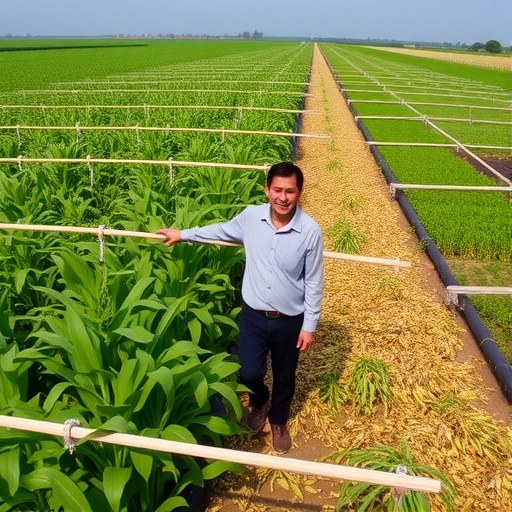U.S.-China Trade Deal Offers Lifeline to Struggling Farmers: Soybean Purchases Set to Rebound
In a pivotal moment for rural America, the newly inked U.S.-China trade deal has ignited hope among Farmers battered by years of economic turmoil. China’s commitment to ramp up purchases of American agricultural products, particularly soybeans, could inject billions into the heartland, easing the pain of plummeting prices and export barriers that have plagued the sector since the trade war began in 2018.
Farmers across the Midwest, from Iowa’s vast cornfields to Illinois’ soybean belts, have been holding their breath amid falling crop values and mounting debts. Now, with Beijing pledging to resume substantial soybean purchases under the trade deal, industry leaders predict a swift recovery. “This is the break we’ve been waiting for,” said Tom Vilsack, U.S. Secretary of Agriculture, in a statement released yesterday. “It restores market access and stability to our agriculture community.”
Farmers’ Years of Hardship from Trade War Fallout
The U.S. agriculture sector has endured a rollercoaster since President Trump’s tariffs sparked retaliatory measures from China in 2018. Soybean exports to China, once accounting for nearly 60% of U.S. shipments, cratered by over 75%, according to USDA data. This led to surplus stockpiles, depressed prices, and farm bankruptcies surging 20% in 2019 alone.
In states like Iowa, where soybeans are king, the impact was devastating. Family farms, passed down for generations, faced foreclosure as income dropped by an average of 15% annually. “We’ve been planting the same fields for decades, but without China buying our crops, it’s like farming into a black hole,” shared Mike Petersen, a third-generation farmer from Des Moines. His operation, like many, relied on those exports to turn a profit; last year’s soybean prices hovered around $9 per bushel, far below the $12 break-even point for most growers.
The ripple effects extended beyond the fields. Rural communities saw job losses in grain elevators, trucking, and equipment sales. A 2022 Federal Reserve study highlighted how agriculture-dependent counties experienced a 10% rise in poverty rates, exacerbating mental health crises among farmers. Government bailouts, totaling $28 billion through the Market Facilitation Program, provided temporary relief but couldn’t replace lost international markets.
Experts point to China’s dominance in global ag trade as the crux of the issue. As the world’s largest importer of soybeans for animal feed and oil, its pivot to suppliers like Brazil left U.S. farmers sidelined. Brazil’s soybean exports to China jumped 50% during the trade spat, underscoring the vulnerability of American agriculture to geopolitical tensions.
Key Provisions of the U.S.-China Trade Framework
The trade deal, finalized after months of negotiations, builds on the Phase One agreement from 2020 but addresses long-standing grievances with more enforceable commitments. At its core is China’s pledge to purchase $40 billion worth of U.S. agricultural goods annually over the next two years, with soybeans comprising at least 50% of that volume.
Under the framework, tariffs on U.S. farm products will be reduced by 25% within six months, and non-tariff barriers—like stringent biotech approvals—will be streamlined. This includes faster certification for genetically modified crops, a boon for innovators in the sector. The deal also establishes a bilateral dispute resolution mechanism to prevent future escalations, monitored by the World Trade Organization.
U.S. Trade Representative Katherine Tai emphasized the deal’s reciprocity: “In exchange for market access, China commits to intellectual property protections for American seed technologies, safeguarding our competitive edge.” This addresses theft concerns that have long irked agribusiness giants like Monsanto and Corteva.
Statistics from the U.S. Grains Council project that full implementation could boost soybean exports by 15 million metric tons in the first year, equivalent to $7 billion in revenue. Corn and pork exports are also targeted, with China agreeing to lift bans on U.S. meat products imposed during the trade war over African swine fever fears.
While not a full resolution to all trade imbalances, the agreement marks a thaw in relations. President Biden hailed it as “a win for American workers and families,” during a White House briefing, noting its alignment with broader supply chain resilience goals.
Soybean Purchases Resume: Midwest Farmers Gear Up for Harvest
For soybean farmers, the trade deal is nothing short of a resurrection. Iowa, the top U.S. producer with 10 million acres under cultivation, stands to gain the most. The state exported $4.5 billion in soybeans to China pre-trade war; analysts forecast a return to $3 billion within 18 months.
“We’re already seeing futures prices tick up 8% since the announcement,” noted Darren Frye, a commodity analyst at DTN Progressive Ag. Soybean contracts for November delivery climbed to $10.50 per bushel on the Chicago Board of Trade, signaling investor confidence. This uptick could add $200 per acre to farmers’ bottom lines, enough to cover rising input costs like fertilizer, which have soared 30% due to global energy prices.
In Illinois and Minnesota, similar optimism prevails. The American Soybean Association reported that 70% of its members plan to expand planting acreage by 5-10% next season, betting on sustained Chinese demand. “China’s hog industry is rebounding post-swine fever, and they need our protein-rich beans,” explained association CEO John Heisdorffer.
However, challenges remain. Weather patterns, including droughts in the Plains, could limit yields—2023 projections sit at 50 bushels per acre, down from 52 last year. Logistical hurdles, such as port congestion at the Mississippi River, might delay shipments. Still, infrastructure investments under the Bipartisan Infrastructure Law, including $1.2 billion for rural broadband and rail upgrades, aim to smooth these bottlenecks.
Farmers like Sarah Jenkins from Ohio, who diversified into cover crops during lean times, see the deal as validation. “We’ve innovated to survive, but now we can thrive,” she said, highlighting how the trade deal encourages sustainable practices eligible for premium pricing in China.
Wider Boost for U.S. Agriculture and Rural Economies
Beyond soybeans, the trade deal promises dividends across agriculture. Wheat farmers in Kansas and beef producers in Texas anticipate renewed access to China’s 1.4 billion consumers. Pork exports, hit hard by the 2019 trade bans, could rebound by 20%, per USDA estimates, benefiting states like North Carolina.
The economic multiplier effect is significant: every $1 billion in ag exports supports 8,500 jobs, according to a Purdue University study. Rural banks, strained by loan defaults, expect a surge in lending for equipment and expansion. Community anchors like cooperatives and 4-H programs, which suffered funding cuts, may see revitalization through increased local spending.
Environmental angles add intrigue. The deal includes provisions for carbon-neutral farming incentives, aligning with China’s green initiatives. U.S. farmers adopting precision agriculture—using drones and AI for efficient planting—could qualify for export bonuses, reducing emissions by up to 15% while boosting yields.
Critics, including some free-trade advocates, caution that over-reliance on China poses risks. “Diversification to markets in India and Southeast Asia is essential,” warned economist Bruce Babcock from Iowa State University. Yet, the immediate relief is undeniable, with farm income projected to rise 12% in 2024 by the American Farm Bureau Federation.
Women and minority farmers, often underserved, stand to benefit too. Programs tied to the deal will prioritize outreach to these groups, potentially increasing their share of exports from 5% to 10%. Quotes from leaders like Zippy Duvall, AFBF president, underscore unity: “This trade deal unites our diverse farming community in pursuit of prosperity.”
As planting season approaches, the buzz in rural diners and ag forums is palpable. Input suppliers report a 15% uptick in orders, from seeds to combines. The trade deal isn’t just policy—it’s a narrative of resilience, turning the page on hardship for America’s agricultural backbone.
Looking ahead, implementation hinges on swift action. The USDA plans quarterly reviews with Chinese counterparts, while Congress debates supplemental funding for trade promotion. If fulfilled, this pact could stabilize prices for years, fostering innovation and growth. For farmers staring down another uncertain harvest, the message is clear: relief is on the way, sown in the fertile ground of renewed trade ties.








